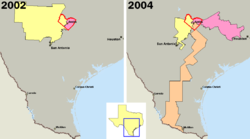Donald J. Trump likes issuing dire warnings about a “rigged election” on the horizon.
He means, of course, that the presidential election will be rigged and that the Republican nominee will lose only because of “crooked” politicians seeking to grease it for Democratic nominee Hillary Rodham Clinton’s election to the presidency.
Trump is mistaken, but only partially so.
Yes, the election at another level will be “rigged.” The rigging occurs in the election of members of Congress.
The culprit is the tried-and-tested method of gerrymandering, which the Republicans in charge of Congress and in many state legislatures around the country have fine-tuned to an art form.
David Daley writes in a blog for BillMoyers.com that the rigging will allow the GOP to maintain control of the House of Representatives, even as the Senate could flip to Democratic control — and as Clinton is swept into the White House in a landslide.
http://billmoyers.com/story/real-way-2016-election-rigged/
Yep. The GOP has done well with this totally legal process of apportioning House congressional districts. It’s done every 10 years after the census is taken and ratified.
They have gerrymandered the dickens out of the House districts, drawing lines in cockamamie fashion to include Republican-leaning neighborhoods and to shut out Democrats.
Now, to be totally fair and above-board, this isn’t a uniquely Republican idea. Democrats sought to do it, for example, in Texas when they ran the Legislature. As recently as 1991, the Democratic-controlled Texas Legislature monkeyed around with congressional districts, seeking to protect Democratic incumbents in the U.S. House.
Amarillo became something of a testing ground for that experiment. The Legislature divided the city into halves, with the Potter County portion of the city included in the 13th Congressional District, while the Randall County portion was peeled off into the 19th District. Potter County contained more Democratic voters and the idea was to protect then-U.S. Rep. Bill Sarpalius of Amarillo, a true-blue Democrat, from any GOP challenge.
Randall County, meanwhile, is arguably ground zero of the West Texas Republican movement and its residents ain’t voting for a Democrat to any public office.
The tactic worked through the 1992 election, when Sarpalius was re-elected. Then came the 1994 Republican wipeout, led by that firebrand Rep. Newt Gingrich of Georgia. Sarpalius got swept out by the GOP tsunami that elected a young Clarendon rancher and self-proclaimed “recovering lawyer” named Mac Thornberry.
The Republicans would wrest control of the Legislature from the Democrats after that and they have perfected the art of gerrymandering. Sure, the Democrats tried to gerrymander themselves into permanent power.
Republicans, however, have proved to be better at it.
You want a “rigged” election? There it is.
The GOP presidential nominee, quite naturally, isn’t about to call attention to the real rigging of the U.S. electoral system. Instead, he’s going to fabricate suspicion in a scenario that will not occur.


